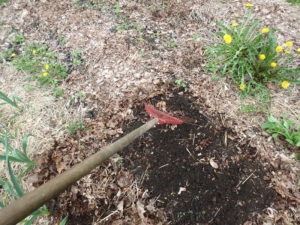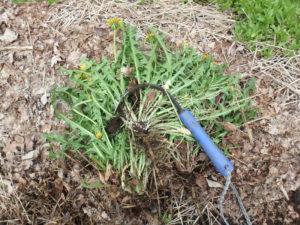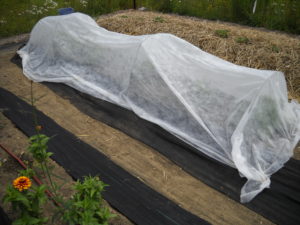Tips for a Successful Vegetable Garden
Depending where you live – a cold hollow, a hilltop, or near a large body of water, you may be ready to start planting the vegetable garden – or not. In any case, there is much to do before your plants go in the ground. Here are some tips to consider. In my opinion, there is not much point in planting seeds or seedlings until the soil has warmed up sufficiently. A soil thermometer will tell you when it hits 60 degrees a few inches the soil surface; 60 degrees is good even for cold weather crops like spinach and peas, although you can plant them into cooler soil. Cold, wet soil may rot seeds and discourage seedlings.
Last fall I covered my garden with leaves and straw; I start work in the vegetable garden by raking those off. This will allow the soil to absorb the sun’s heat directly. If I’m in a hurry, sometimes I will cover a few rows with clear plastic and seal the edges with soil or mulch so the heat will build up.
On a sunny day it will get up over 100 degrees under clear plastic, which will also cook and kill many germinating weed seeds. It won’t kill perennial weeds or grasses, as the roots will survive even the hottest of days under plastic. Black plastic also holds in the heat, but is slightly less effective in heating the soil.
I don’t believe in rototilling, except perhaps when mixing in a thick layer of compost to a new bed, and even then I recommend a shallow tilling. Rototilling makes the garden look good, but it is not good at killing weeds. It just cuts up those perennial roots and spreads them around. Instead of having a hundred weeds, you can have a thousand. Soil organisms each have found the perfect place to live; stirring up the soil only disrupts their habitat.
After raking off the mulch into the walkways, I weed. Yes, I weeded last fall. But I will have missed plenty of little ones, and others have germinated from seed by now. I like the CobraHead weeder best. This curved tool gets under weeds, loosens the roots, and lets me get the plant and its entire root system easily. Of course, you probably have a favorite tool and whatever works best for you is the right tool. CobraHead makes a long handled version, but I don’t mind bending over to weed.
Meanwhile, I have been hardening off my vegetable starts, and will continue to do so. Just as you would not put a baby in the sun without sunscreen, I won’t put my baby tomatoes out in the garden without preparation.
I start by putting out the flats of seedlings on a deck that only gets morning sun for a few days. Then I give them morning sun and a couple of hours of afternoon sun. After a few days of this, they are ready for all day sun. The stems have gotten stronger, the leaves are used to wind and sun, and they are ready to plant.
When do I plant? I planted spinach seedlings around May 8 or 10. Lettuce and kale seedlings are growing in my cold frame that warms up the soil and keeps them cozy at night. But my tomatoes? I wait well past the last chance for frost to plant. I also know that they will sulk – and stop growing – if the soil is too cold or if the nights too chilly. I have been carrying them inside at night during the hardening off process.
Plants that do well in cooler temperatures include the following: arugula, beets, broccoli, Brussels sprouts, cabbage, carrots, celeriac, kale, kohlrabi, lettuce, leeks, onions, parsley, peas, potatoes, radishes, rutabagas, spinach and Swiss chard. All the rest, especially sweet potatoes, tomatoes and all the vine crops can be seriously set back by chilly nights and killed by frost.
Now is a good time to plant some vine crops in small pots inside. I have a terrible time with the striped cucumber beetle. If I plant seeds outdoors, the beetles miraculously appear the night the seeds germinate and eat those first two little leaves. That kills the plant. But if I get vines 6 inches long with a few real leaves, the beetles can chew on the leaves, but won’t kill them. Cukes, squash, watermelon and pumpkins all are attractive to those nasty critters.
Another way of protecting crops from marauding insects and furry critters is to cover them with a thin agricultural fabric called row cover – also called Reemay or Agribon (trade names). This stuff will let sun through, as well as moisture and air. You can drape it right over the plants, or stretch it over wire hoops that are sold for the purpose. It comes in 5-foot wide rolls, which is perfect for a wide raised bed. You need to buy earth staples to pin it down. It comes in varying thickness; thick ones will keep things warmer, but allow less light to come through.
Later, when your cukes and squash start to flower, you need to take off the covers as insects pollinate the plants. Peppers and eggplants benefit from the extra heat contained by the row covers, and are wind pollinated. Generally they do fine under row cover.
One last piece of advice: ask at the greenhouse if the seedlings you are buying have been hardened off. Being inside a greenhouse is much less stressful than being outside directly in the sun. Leaves can actually get sunburned if not hardened off outside. They will recover, but slowly. So you may need to harden them off before planting.
Memorial Day weekend is the traditional day for planting warm weather crops in my area. But I never hesitate to wait a bit longer. The plants will always catch up.
Write Henry at PO Box 364, Cornish Flat, NH 03746 or e-mail henry.homeyer@comcast.net.





